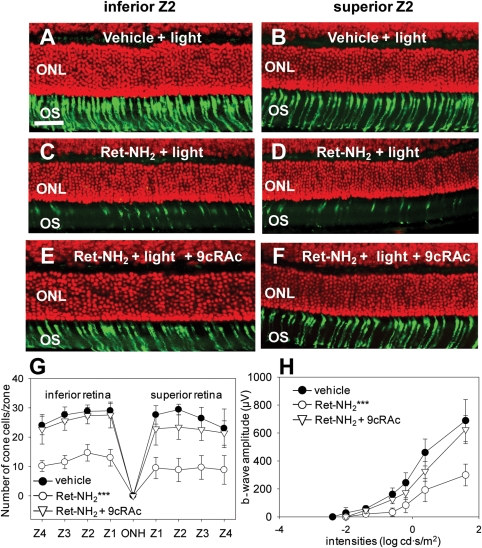Figure 5.
Cone photoreceptor cell degeneration due to chromophore deficiency in Gnat1−/− mice is prevented by 9-cis-retinyl acetate (9cRAc) administration. To determine whether the cone photoreceptor cell death observed in Gnat1−/−Lrat−/− and Gnat1−/−Rpe65−/− mice might be induced by 11-cis-retinal deficiency, a phenotype mimicking this condition was produced in Gnat1−/− mice by administration of the retinoid cycle inhibitor, retinylamine. Four-week-old Gnat1−/− mice were gavaged with retinylamine (Ret-NH2)(250 µg/g body weight) followed 6 h later by strong light bleaching (500 cd/m2 for 30 min) on day 1 and maintained in the dark for a week (from days 1–7); the same regimen was repeated during the following week (from days 8–14). Cone photoreceptor cell death and function were evaluated by viewing retinal histology (PNA, green for cone photoreceptors; DAPI, red for nuclei), counting cone cell numbers, and recording ERGs on day 14. To determine the effects of artificial chromophore replenishment on cone photoreceptor cells, mice undergoing the 2 week retinylamine/bleaching chromophore depletion regimen were supplemented with 9-cis-retinyl acetate gavaged at 50 µg/g body weight three times a week (day 2, 4, 6, 9, 11 and 13). Cone photoreceptor immunohistochemistry, populations and function were then evaluated on day 14. No significant effects on cone photoreceptor immunohistochemistry (A and B, bar indicates 10 µm), population (G) or ERG responses (H) were observed after light exposure in Gnat1−/− vehicle-treated control mice, whereas chromophore deprivation by retinylamine gavage and light exposure induced drastic cone photoreceptor degeneration in both the inferior and the superior retina (C, D, G ***, P < 0.0001) of Gnat1−/− mice. Retinal dysfunction in these animals was also evidenced by ERG recordings (H ***, P < 0.0001). However, cone photoreceptor immunohistochemistry, populations and function were maintained in 9-cis-retinyl acetate-treated Gnat1−/− mice comparably to vehicle-treated control animals (E, F, G, H). OS, outer segments; ONL, outer nuclear layer. Bars indicate SDs; n =3–6/each group.

